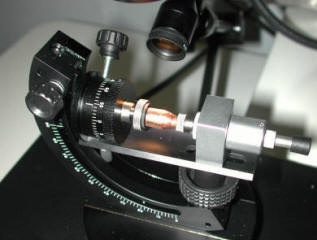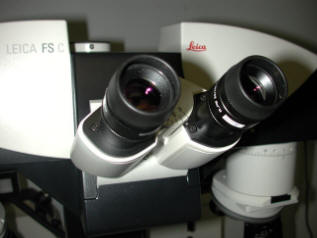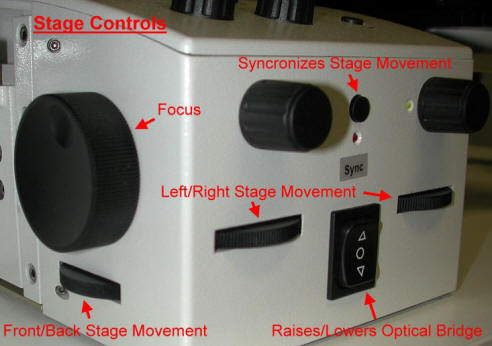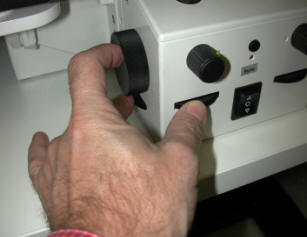Product Review
Leica
FS C Forensic Comparison Macroscope
by Scott Doyle
Power-Up!
Click! I just turned the FS C on!
The switch on the right side of the base lit up to a bright orange, a little green light located
on the right front of the optical bridge turned on, the central control module
lit up like a Christmas tree and... did I tell you the FS C is loaded with
motors? Well, when you turn on that power switch you better get everything
away from the stages because they start moving all over the place!
Actually they move to the outer limits of their X and Y range which calibrates
the position of each stage.
I also at this point turned on the light
source. You have to have light to view the various objects that are to be
compared!
 Now
that FS C was all powered up I attached a bullet to the bullet holders on each
stage. Included with the FS C are a number of different bullet and
cartridge case holders. All of these are very well made and do a great job
of holding onto the pieces of evidence to be examined. Now
that FS C was all powered up I attached a bullet to the bullet holders on each
stage. Included with the FS C are a number of different bullet and
cartridge case holders. All of these are very well made and do a great job
of holding onto the pieces of evidence to be examined.
The holder seen there on the
left allows for every conceivable position of the bullet and it is very easy to
rotate the bullet on it's axis. One small complaint is the large screw set
into the rotational control. This screw definitely looks like an
after-thought by the engineers and is there to lock the rotational movement.
I will probably remove the screw all-together as there is more than enough
firmness in the rotation of this part to prevent it from rotating on its own.
So I now had a couple bullets
mounted on the stages and I was ready to see what the FS C is all
about. I slid in under the table and took a peek in the eyepiece and I saw that I've got a few things I need to get into position before I can start
"matching bullets". This is where things immediately got real interesting!
 I first had to adjust the
optical bridge upward to allow for more distance between the objectives and the
bullets on the stages. This is accomplished by simply rocking the button
that is located on the lower front of the control module upward. You can
see it below just between the lower two wheels. The optical bridge can be
lowered just as easy. In raising the optical bridge it brought the
binocular eyepiece up and a little too high for my sitting height. No
problem! I just reached up and pulled down on the binocular eyepiece and
moved it to the correct height for my eyes. This may not sound like a big
deal but this is the first comparison macroscope that I can think of that has
ever allowed for positioning of the eyepiece in this way! I first had to adjust the
optical bridge upward to allow for more distance between the objectives and the
bullets on the stages. This is accomplished by simply rocking the button
that is located on the lower front of the control module upward. You can
see it below just between the lower two wheels. The optical bridge can be
lowered just as easy. In raising the optical bridge it brought the
binocular eyepiece up and a little too high for my sitting height. No
problem! I just reached up and pulled down on the binocular eyepiece and
moved it to the correct height for my eyes. This may not sound like a big
deal but this is the first comparison macroscope that I can think of that has
ever allowed for positioning of the eyepiece in this way!
Getting the height of the
bridge into the correct position I next had to get the bullets positioned
squarely beneath the objectives and in focus. Instead of reaching under
the stages and turning knobs to move the bullets into position there are these
three wheels on the front and each side of the central control module that move the stages X, Y, and Z.
See the illustration below.

These are some smart wheels that are turned to move the stages.
Not only do they move the stages they also know what magnification you are using
and dampen the movement accordingly! For example, let's say you move a
wheel 1/4 turn at 10X and it moves the stage 1/4 inch. Well if you go to
40x and move the wheel 1/4 of a turn it would also magnify the distance moved by
4 times. Way too much! So the FS C automatically dampens down the
the stage movement. The result is that, no matter what magnification you
are using, the movement of the stages seems uniform in speed and distance.
This is something that cannot be accomplished with manual controls!
I
positioned my thumb on the front wheel, my middle finger on the side wheel and
my index finger on the focus wheel and in no time was moving the bullets around
within the field of view of the optics. The larger focus wheel has a small
detent that you can put the tip of your finger in to spin it. This is
important because the objectives are not exactly parfocal. When you
change the magnification you will have to re-focus.
One very neat feature that I
think Leica copied from my virtual comparison microscope is the sync feature
(just kidding). Pushing the "Sync" button on the front of the control
module will cause the stages to move in unison with each other. Pretty
cool! It is very common for examiners to move the stages back and forth to
view the striae and the sync function allows this to be done with little effort.
Even the focus is sync'd. One little complaint though. The label is
a cheap little sticker that looks like it was stuck on the front of the FS C by
someone who was on a rocking boat. Very out of character with everything
else on the FS C.
Next-Operation
|